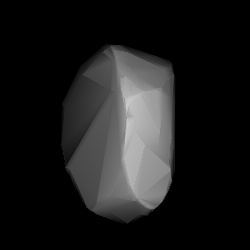 Shape model of Tselina from its lightcurve | |
| Discovery [1] | |
|---|---|
| Discovered by | T. Smirnova |
| Discovery site | Crimean Astrophysical Obs. |
| Discovery date | 13 June 1969 |
| Designations | |
| (2111) Tselina | |
Named after | Virgin Lands Campaign (agricultural program) [2] |
| 1969 LG ·1928 RS 1928 SO ·1951 AR1 1968 HB1 ·1975 RE 1976 YF | |
| main-belt ·(outer) Eos [3] [4] | |
| Orbital characteristics [1] | |
| Epoch 4 September 2017 (JD 2458000.5) | |
| Uncertainty parameter 0 | |
| Observation arc | 48.47 yr (17,703 days) |
| Aphelion | 3.3041 AU |
| Perihelion | 2.7299 AU |
| 3.0170 AU | |
| Eccentricity | 0.0952 |
| 5.24 yr (1,914 days) | |
| 318.00° | |
| 0° 11m 17.16s / day | |
| Inclination | 10.503° |
| 167.17° | |
| 232.54° | |
| Physical characteristics | |
| 22.773±0.247 km [5] 22.830±0.208 km [6] 24.54±2.8 km [7] 33.02±0.64 km [8] | |
| 6.563±0.001 h [9] | |
| 0.130±0.006 [8] 0.1938±0.054 [7] 0.2258±0.0251 [6] 0.226±0.027 [10] | |
| Tholen = S [1] · S [3] B–V = 0.799 [1] U–B = 0.463 [1] | |
| 10.45 [1] [3] [6] [8] ·10.730±0.001(R) [11] | |
2111 Tselina (prov. designation: 1969 LG) is a stony Eos asteroid from the outer regions of the asteroid belt. It was discovered on 13 June 1969, by Soviet astronomer Tamara Smirnova at Crimean Astrophysical Observatory in Nauchnij, on the Crimean peninsula. [12] The S-type asteroid has a rotation period of 6.6 hours and measures approximately 23 kilometers (14 miles) in diameter. It was later named after the Soviet Virgin Lands Campaign. [2]